Growing Ficus Elastica ‘Rubber Plant’ – They Add A Lot Of Colour To A Home
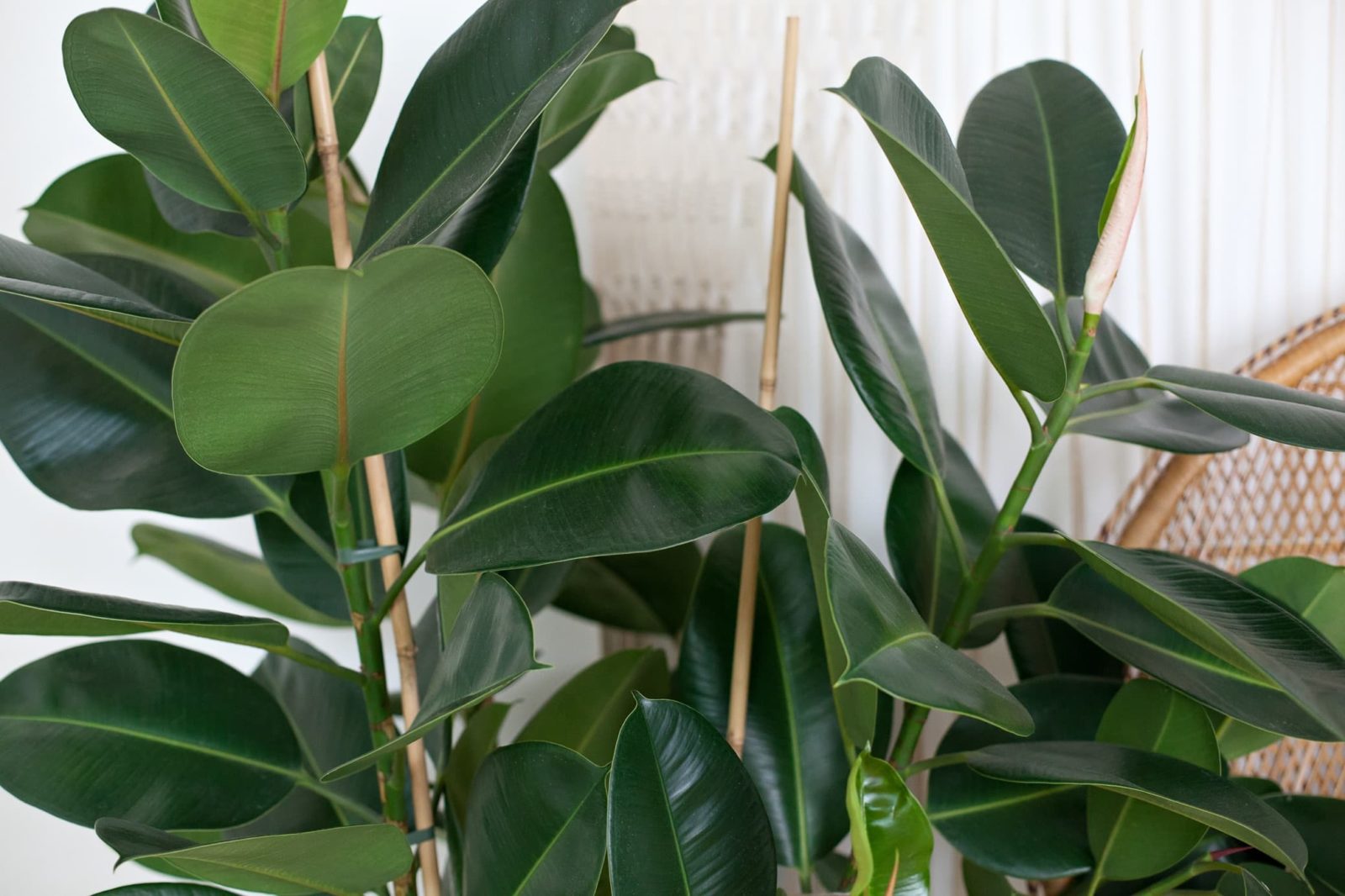
HOUSEPLANTS > FICUS > ELASTICA
Chris is a gardening writer and nature enthusiast. He graduated from Oxford Brookes University in 2022 with an MA in Psychology. Chris works with the Leeds Green Action Society, helping their food cooperative by growing various fruit and vegetables on their two allotments in Hyde Park, Leeds.
Reviewed By COLIN SKELLY

Colin is a Horticulturist and Horticultural Consultant with experience in a range of practical and managerial roles across heritage, commercial and public horticulture. He holds the Royal Horticultural Society’s Master of Horticulture award and has a particular interest in horticultural ecology and naturalistic planting for habitat and climate resilience.
IN THIS GUIDE
FICUS GUIDES
Ficus Benjamina
– Drooping Leaves
Fiddle Leaf Fig
Rubber Plant
If you or your friends keep houseplants, it’s very likely that you’ve seen at least one Ficus elastica in your life.
This popular plant is ideal for growing at home thanks to its distinct and attractive aesthetic, its resistance to pests, and its general low maintenance requirements.
Overview
| Botanical Name | Ficus elastica |
| Common Name(s) | Rubber Tree, Rubber Plant, India Rubber Plant |
| Plant Type | Houseplant / Tree |
| Native Area | East Himalaya to North Malaysia |
| Hardiness Rating | H1B |
| Foliage | Evergreen |
| Flowers | Inconspicuous |
| When To Sow (Indoors) | Year-Round |
| Flowering Months | May, June |
| When To Prune | February, March |
Sunlight
Preferred
Full Sun
Exposure
Sheltered
Size
Height
2.5 – 4M
Spread
1 – 1.5M
Bloom Time
Summer
Soil
Preferred
Most Soil Types
Moisture
Moist but well drained
pH
Any
F. elastica is the botanical name for a plant more commonly known as rubber plant, rubber tree, Assam rubber, India rubber fig, and many other names.
According to records from Kew, its native range spans much of South East Asia and Southern China.1Ficus elastica. (n.d.). Kew Royal Botanic Gardens. Retrieved March 15, 2023, from https://powo.science.kew.org/taxon/urn:lsid:ipni.org:names:60458499-2

Confusingly, another plant called Hevea brasiliensis also goes by the names ‘Rubber Tree’ and ‘Rubber Plant’; this species is the primary source of natural rubber.
Why Grow A Rubber Tree?
F. elastica ticks many of the boxes that houseplant enthusiasts look for:
- It’s pretty to look at, boasting thick rubbery leaves that hold a lot of colour.
- There are a variety of shades and colours available, from greens through to burgundies.
- It’s not too big. While the plant can grow over 20 metres tall in its natural habitat, a houseplant will clock in around a metre.
- It’s easy to look after, requiring no special treatment and fairly infrequent watering.
- It’s unlikely to attract pests, meaning there’s less scope for things to go wrong.
- It’s easy to clean – if yours are liable to get dusty, F. elastica’s strong leaves lend themselves well to a gentle rubdown.
Easy enough to appeal to beginners, but versatile and attractive enough to remain appealing to even the most seasoned experts.
How To Grow A Rubber Plant
Buying a mature rubber plant is probably the most popular way of incorporating one into your squadron of houseplants, and they’re fairly cheap to buy from most gardening shops.
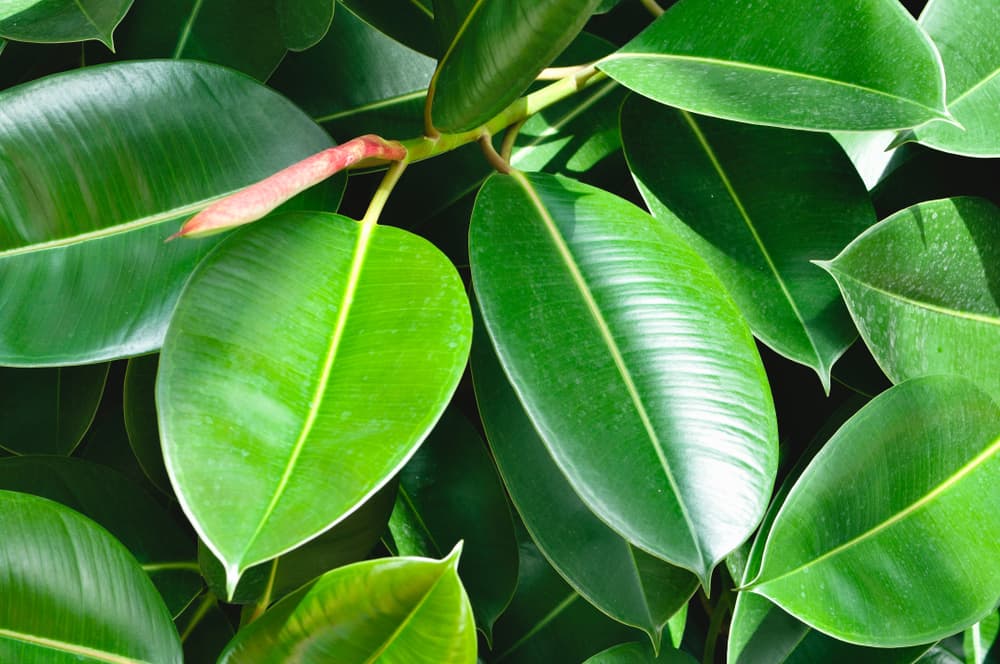
If you’re feeling adventurous, though, they’re not too challenging to grow from seeds or cuttings.
Growing From Seed
Unlike many seeds, you don’t need to bury a rubber plant seed in soil to get it growing.
Instead, leave it in a tray or container in indirect sunlight, and spritz it a few times a day to keep it moist.
You can place a light cloth over the seed whilst you spritz it to ensure better coverage.
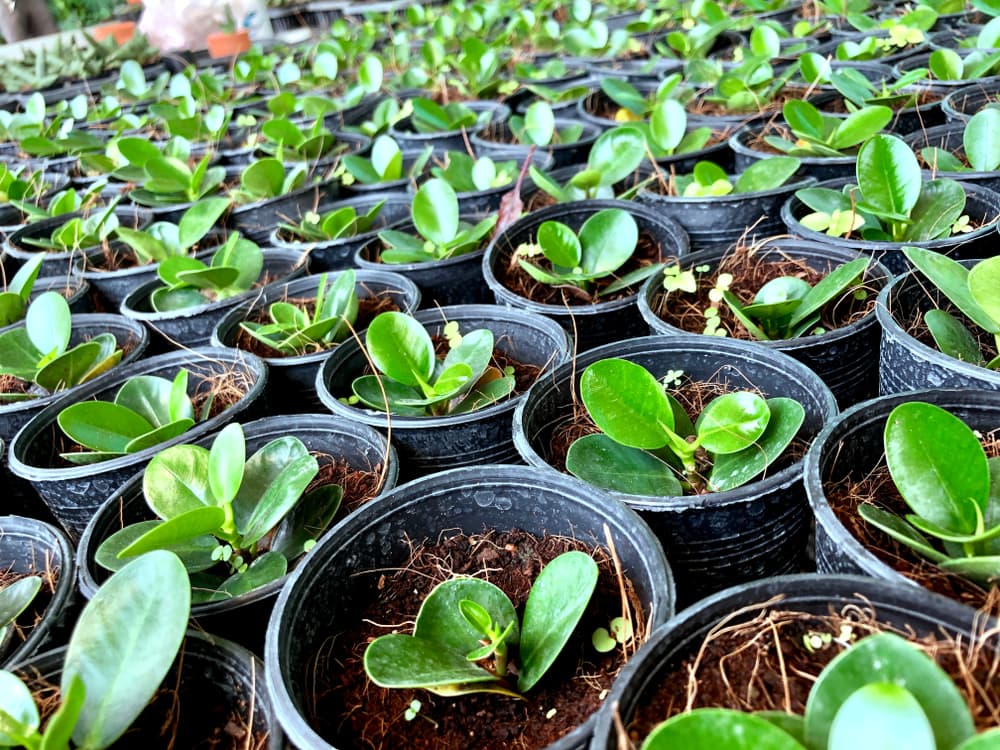
Once the seed has sprouted, usually after a week or so, you can relocate it to a pot.
Aim for loam-based compost, and continue to keep the seedling in indirect light while it builds strength.
Be gentle when moving the seedling as it will be very delicate.
Growing From A Cutting
Taking a cutting from a mature plant is a great way to get a new rubber plant.
“Houseplants are more often sold as plants than seeds, so cuttings might be the best way to add to your plant collection, especially for Ficus, which roots quite readily,” shares Colin Skelly, a Horticultural Consultant.
“If your plant is growing happily then your cuttings should grow well in the same position until they are large enough to move elsewhere.”
You’re looking to cut about 10cm of the stem from the mother plant; taking care to make sure there are 2 or 3 leaf nodes on the stem (a node is a section where the leaf joins the stem).
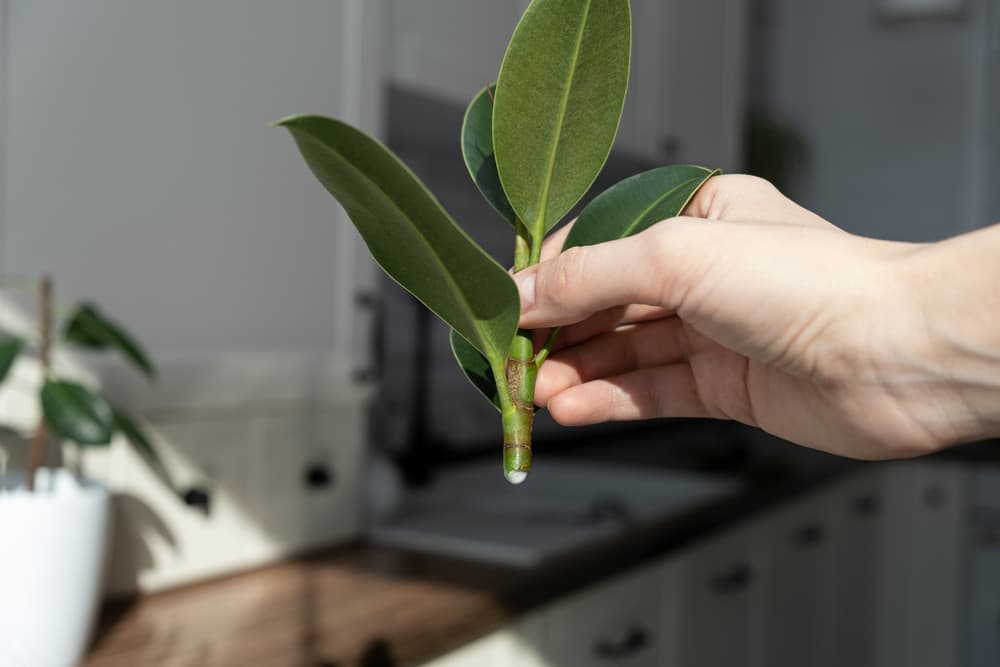
Then, you need to plant the stem in soil mixed with rooting medium.
Plant up to half of the stem below the soil, with all the leaves above the surface, then water the soil, cover the plant with plastic and leave it to grow.
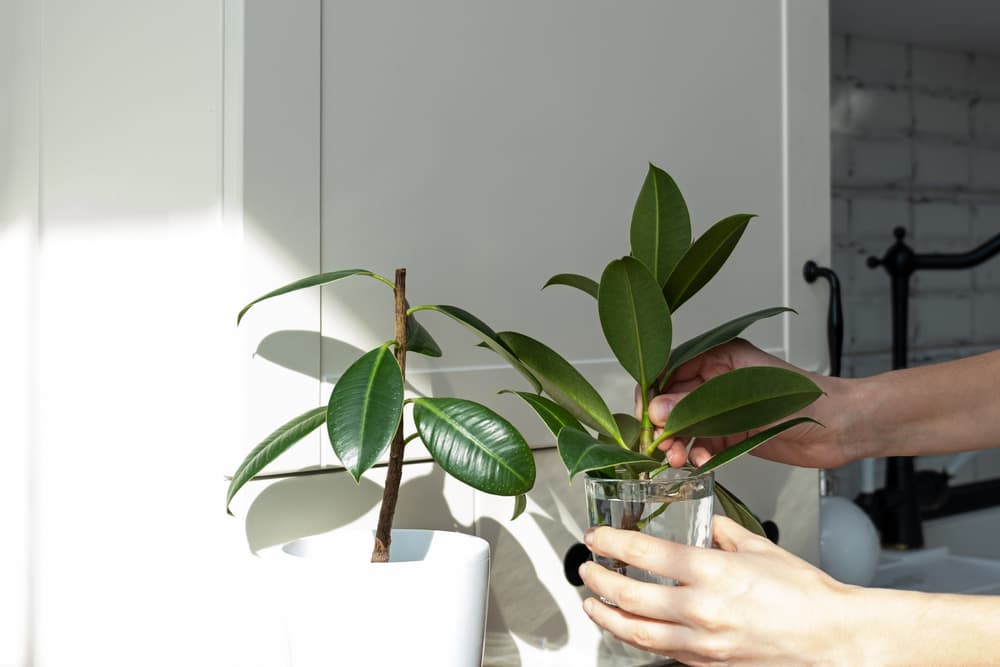
After a couple of weeks the stem will have rooted beneath the soil.
When the roots are between 3-5cm long, it’s safe to relocate the plant to a bigger pot – again, be gentle!
Rubber Tree Care
Fertilising
For optimal condition, give your rubber plant a dose of liquid fertiliser every couple of weeks during the spring and summer months.
Check the label of the fertiliser you use to ensure the correct dilution, as you don’t want to overfeed your plant.
Watering
One of the most common causes of rubber plant problems is over-watering, so read this section carefully.
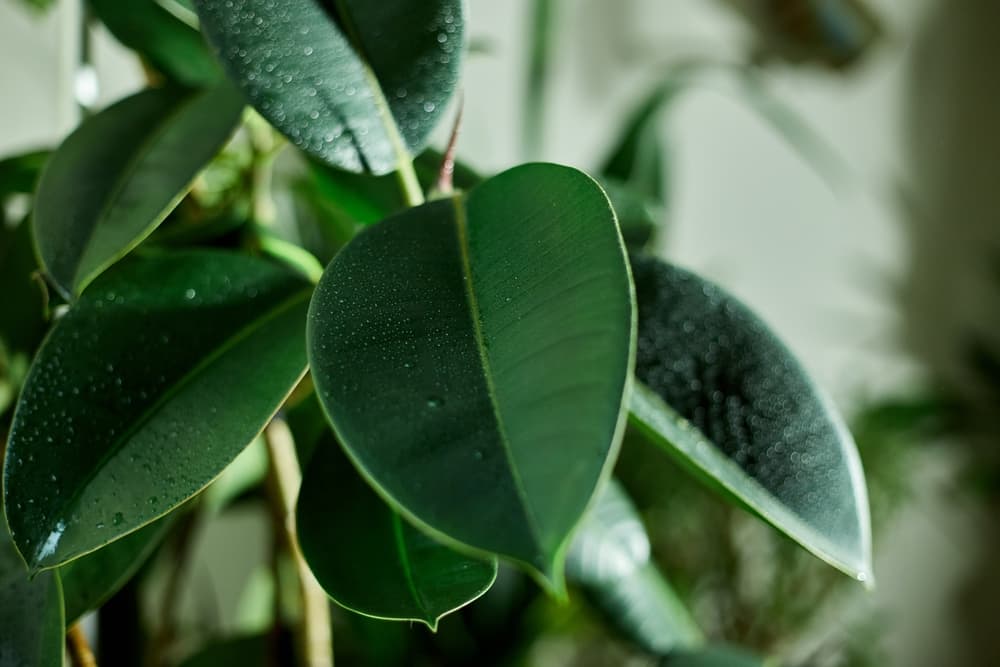
Rubber plants only need watering when the soil begins to feel dry.
Poke a finger an inch or so into the soil and water when things are starting to feel dry.
Don’t wait until it’s bone dry, and don’t water when the soil is clearly moist, either.
You should only keep rubber plants in pots with sufficient drainage – this gives water ample opportunity to be absorbed into the plant, while allowing excess water to drain away.
Pruning
As we mentioned earlier, in the wild, rubber plants can grow to enormous heights exceeding 20-30m.
Unless you live in an equally enormous house, it’s unlikely you’ll want your plant to reach full height.
Thankfully, pruning rubber plants is easy – simply trim the top off of your plant when it reaches the desired height.

You can also tidy up leaves further down the plant, cutting them back to keep things looking orderly.
Ideally you’d do this in the spring and summer months, but if you have a sudden desire to prune in the other seasons, your plant will be able to recover.
Common Problems
In the watering section we mentioned that over-watering is one of the most common issues.
Here’s what else to look for in a rubber plant –
Losing Leaves
Wilting, damaged, and dying leaves are the main symptom of over-watering.
If you’re seeing this, water less frequently, remind yourself when to water, and consider repotting your plant into dryer soil.
Pests
When grown under glass, rubber plants are prone to mites, scale bugs, mealy bugs, and other pests.
These critters can cause various mayhem to plants, often involving feeding on the sap inside their leaves.
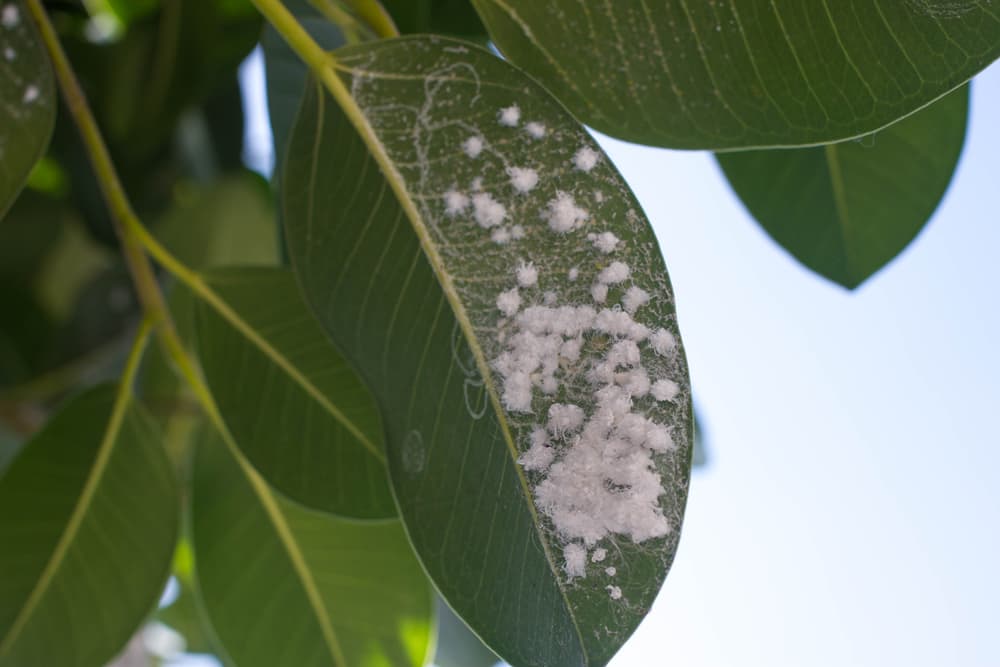
With a pest infestation it’s likely you’ll be able to see eggs, excrement, or the bugs themselves with the naked eye.
The first step is to remove them by hand and gently clean the leaf – then give it a few days and see if the problematic visitors return.
If so, you’ll want to move on to pesticides – choosing a product that discourages ongoing visits whilst avoiding damage to your plant.
There are a variety of products available, ranging in strength and price.
References
- 1Ficus elastica. (n.d.). Kew Royal Botanic Gardens. Retrieved March 15, 2023, from https://powo.science.kew.org/taxon/urn:lsid:ipni.org:names:60458499-2
